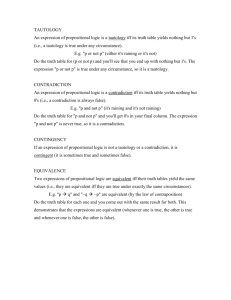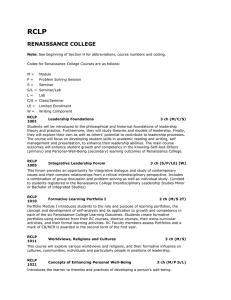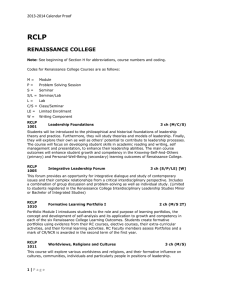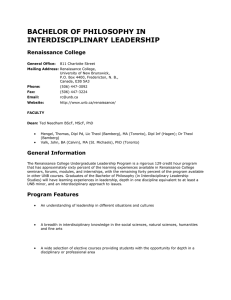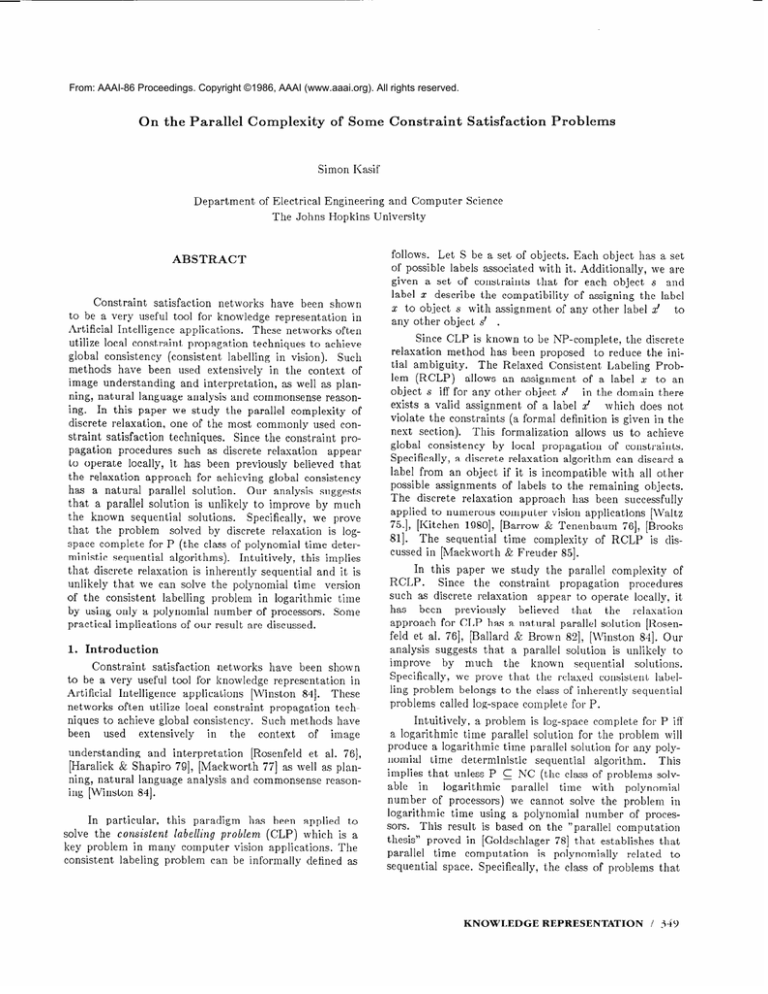
From: AAAI-86 Proceedings. Copyright ©1986, AAAI (www.aaai.org). All rights reserved.
On the Parallel
Complexity
of Some Constraint
Simon
Department
of Electrical
The Johns
Satisfaction
Problems
ICasif
Engineering
Hopkins
ABSTRACT
Constraint
satisfaction
networks
have been shown
to be a very useful tool for knowledge
representation
in
Artificial Intelligence
applications.
These networks often
utilize local constraint
propagation
techniques
to achieve
global consistency
(consistent
labelling in vision).
Such
methods
have been used extensively
in the context
of
image understanding
and interpretation,
as well as planning, natural language analysis and commonsense
reasoning. In this paper we study the parallel complexity
of
discrete relaxation,
one of the most commonly
used constraint satisfaction
techniques.
Since the constraint
propagation
procedures
such as discrete relaxation
appear
to operate
locally, it has been previously
believed that
the relaxation
approach
for achieving global consistency
has a natural
parallel solution.
Our analysis
suggests
that a parallel solution
is unlikely to improve by much
the known sequential
solutions.
Specifically,
we prove
that the problem
solved by discrete
relaxation
is logspace complete for P (the class of polynomial
time deterministic sequential
algorithms).
Intuitively,
this implies
that discrete relaxation
is inherently
sequential
and it is
unlikely that we can solve the polynomial
time version
of the consistent
labelling
problem
in logarithmic
time
by using only a polynomial
number of processors.
Some
practical implications
of our result are discussed.
1. Introduction
Constraint
satisfaction
networks
have been shown
to be a very useful tool for knowledge
representation
in
Artificial
Intelligence
applications
[Winston
841. These
networks
often utilize local constraint
propagation
techniques to achieve global consistency.
Such methods have
been
used
extensively
in
the
context
of image
understanding
and interpretation
[Rosenfeld
et al. 761,
[Haralick & Shapiro 791, [Mackworth
771 as well as planning, natural language analysis and commonsense
reasoning [Winston 841.
In particular,
this paradigm
has been applied
to
solve the consistent labelling problem (CLP) which is a
key problem in many computer
vision applications.
The
consistent
labeling problem can be informally
defined as
and Computer
Science
University
follows.
Let S be a set of objects. Each object has a set
of possible labels associated
with it. Additionally,
we are
given a set of constraints
that for each object s and
label x describe the compatibility
of assigning the label
x to object s with assignment
of any other label X’ to
any other object s’ .
Since CLP is known to be NP-complete,
the discrete
relaxation
method has been proposed
to reduce the initial ambiguity.
The Relaxed Consistent
Labeling Problem (RCLP)
allows an assignment
of a label x to an
object s iff for any other object s’ in the domain there
exists a valid assignment
of a label a! which does not
violate the constraints
(a formal definition is given in the
next section).
This formalization
allows us to achieve
global consistency
by local propagation
of constraints.
Specifically,
a discrete relaxation
algorithm
can discard a
label from an object if it is incompatible
with all other
possible assignments
of labels to the remaining
objects.
The discrete
relaxation
approach
has been successfully
applied to numerous
computer
vision applications
[Waltz
75.1, [Kitchen 19801, [B arrow & Tenenbaum
761, [Brooks
811. The sequential
time complexity
of RCLP is discussed in [Mackworth
22 Freuder 851.
In this paper we study the parallel complexity
of
RCLP.
Since the constraint
propagation
procedures
such as discrete relaxation
appear to operate
locally, it
has
been
previously
believed
that
the
relaxation
approach
for CLP has a natural parallel solution [Rosenfeld et al. 761, [Ballard SC Brown 821, [Winston 841. Our
analysis suggests
that a parallel solution
is unlikely to
improve
by much
the
known
sequential
solutions.
Specifically,
we prove that the relaxed consistent
labelling problem belongs to the class of inherently
sequential
problems called log-space complete for P.
Intuitively,
a problem is log-space complete for P ill
a logarithmic
time parallel solution for the problem will
produce a logarithmic
time parallel solution for any polynomial
time deterministic
sequential
algorithm.
This
implies that unless P & NC (the class of problems solvable
in
logarithmic
parallel
time
with
polynomial
number
of processors)
we cannot solve the problem
in
logarithmic
time using a polynomial
number
of processors.
This result is based on the “parallel
computation
thesis” proved in [Goldschlager
781 that establishes
that
parallel
time computation
is polynomially
related
to
sequential
space. Specifically,
the class of problems
that
KNOWLEDGE
REPRESENTATION
/ 349
can be solved in logarithmic
parallel time with polynomial number
of processors
is equivalent
to the class of
problems
that can be solved in polynomial
time using
logarithmic
space on a sequential
machine.
For length
considerations,
we assume
that the reader is familiar
with elementary
complexity
theory and log-space reducibility techniques
[Garey SC Johnson 701 and the literature
on discrete
relaxation
(network
consistency
algorithms).
For
completeness
we shall
provide
the
necessary
definitions
in the next two sections.
2. Consistent
Relaxation
Labelling
Problems
and
Discrete
The consistent
labelling problem (CLP) and its less
restrictive
(relaxed)
version
are formally
defined
in
[Mackworth
771 and [Rosenfeld et al. 761. For completeness
we give a semiformal
definition
here.
Let
v={v,,....v,}
be a set
of variables.
iVit,h
each
variable Vi we associate a set of labels Li. Now let
be a binary predicate
that defines the compatibility
assigning labels to objects. Specifically,
Yij
of
Pij (5 yj/ )=l
iff the assignment
of label x to ‘ui is compatible wit,11
the assignment
of label y to ‘uuj, The Consistent
Labelling Problem
(CLP) is defined as the problem of finding
an assignment
of labels to the variables
that does not
violate the constraints
given by Pij. More formally,
a
solution to CLP is a vector (x 1, . . . , x,, ) such that xi is
in Li and for each i and j, Pii (xi ,xcj ) = 1.
For example, the d-queens
an instance of CLP. To confirm
with each column
in the board
problem can be seen as
this, associate a variable
and let Li =
1,2,3,4
{
for
>
15; <4.
Let Pij (x ,y )=l iff positioning
of a queen
row x at column i is ” safe ” when there is a queen
column j and row y .
in
in
A.s mentioned
in the introduction,
the
CLP is
Therefore several polynomial
known to be NP-complete.
approximation
algorithms
were proposed and were shown
to perform quite well in practical applications.
The most
significant
class of algorithms
are variations
on discrete
relaxation
[Rosenfeld
et, al. 761 also known as network
consistency
algorithms
[Mackworth
771. Formally,
a
solution to the relaxed version of CLP (RCLP) is a set of
sets M,, . . . , M,, such that A4i is a subset of Li and a
i #j
there is a
label x is in h4i iff for Ej%RY
iMj
Pij (X YYzj ) =
1. Intuitively,
a
Yz. in Mj, SUCh that
label x is assigned to a variable iff for every other variable there is at least one valid assignment
of a label to
that other variable that supports
the assignment
of label
x to the first, variable.
Clearly, any solution to CLP is
also a solution to RCLP but, not vice versa. In this sense
discrete
relaxation
is a form of incomplete
limited reasoning. We call a set n4,, . . . , Al, to be a maximal
solution
for a RCLP iff there does not exist any other
350
/ SCIENCE
such that
n4i C Si for all
solution
S 1, . . . , S,
I< i < 11. We are only interested
in maximal
solutions
fo7 a-RCLP.
This restriction
is necessary
since any
RCLP
has a trivial solution:
the set of empty
sets.
solution
for a RCLP
recall that
any
Additionally,
represents
a set, of candidate
solutions
for the original
CLP, which will eventually
be verified by a final exhaustive check.
Thus, by insisting on maximality
we guarantee that we are not loosing any possible solutions for the
original CLP.
Therefore,
in the remainder
of this paper
a solution for a RCLP is identified with a maximal solution.
The
3.
Graphs
Complexity
of
Searching
AND/OR
In this
section
we state
several
preliminary
definitions
and results that will be used in the following
section to analyze the complexity
of RCLP.
We begin
by defining AND/OR
graphs [Nilsson 711.
An AND/OR
graph is a G-tuple (A ,0 ,E ,S ,S ,r )
0 is a set of OR-nodes,
where A is a set, of AND-nodes,
E is a set of directed
edges
connecting
nodes
in
A UO US UF , s is a unique start node in A , S is a
set of success nodes and F is a set of failure nodes. The
solvability
of a node in an ,4ND/OR
graph is defined
recursively:
-
If x is a S-node,
-
If x is is an AND-node,
then it is solved iff all its
successors
(defined by the direction
of the edges of
E ) are solved.
it is solved.
-
If x is an OR-node then it is solved iff one of its successors is solved.
An AND/OR
graph has a solution iff s is solved.
Proposition 3.1: (Jones & Laaser)
Finding
a solution
for an AND/OR
complete.
Proof:
This result
can be obtained
GAME studied
in [Jones SC Laaser
the problem of AhrD/OR
solvability.
We
clauses.
tional
now
define
the
class
of
graph
is log-space
by observing
that
771 is an instance of
propositional
Horn
A propositional
formula H is said to be a proposiHorn clause iff one of the following holds
-
H is a propositional
assertion.
-
H is a propositional
formula of the form P +
P,&
)...)
8 P,,
denoted
by
P
+
p,, *. ., P, and called an implication.
-
H is a propositional
negative
atom (literal) of the
form 1 P , denoted by +- P and called a goal.
atom
of the form
Q, called
an
We note that our slightly
restrictive
definition
of
Horn clauses (not allowing multiple literals in the goal)
does not, restrict the expressiveness
of the language.
A Propositional Logic Program is a set of propositional Horn clauses with a single goal. We define the
unsatisfiability
of a set of propositional
Horn clauses s as
a solvability
relation on the set of propositional
names in
S. The definition
is recursive:
-
If P is an assertion
in S then
-
If P appears on the left hand
cations of the form
P+P,,...,P,
. . .
side in a set of impli-
Example:
P + P, .
For each terminal
success node Q we create the assertion
Q. Finally if the start node of the graph is labelled by P
we add the goal + P to the set.
It is easy to see that the original graph has a solution iff the set of formulae
created
in this fashion
is
unsatisfiable
and the transformation
can indeed be done
in log-space.
It is not difficult
[Reif 851:
Theorem
The following
set
since P is solvable:
of
+P
P +
P +R t
T +
Horn
clauses
is unsatisfiable
Q,R.
ST.
S.
P.
Q.
The next theorem,
though not explicitly stated
viously in a published
form, is part of the common
lore among theoreticians
[Pullman 851.
prefolk-
(folklore):
The problem of testing the satisfiability
tional Horn clauses is log-space complete.
of
proposi-
that
the following
is also true
3.2:
The Complexity
of RCLP
In this section
we prove our main result, namely
that the problem
of finding a solution to Relaxed CLP
(RCLP)
is log-space
complete.
To accomplish
this we
show that RCLP is in P and subsequently
prove that
satisfiability
of propositional
Horn clauses
(PHSP)
is
reducible
to RCLP.
The first part of the proof is
straightforward
since most existing algorithms
for RCLP
are of polynomial
sequential
complexity
(see [Mackworth
& Freuder
851). In fact the edge consistency
algorithm
as given in [M ac k worth 771 is linear in the number
of
edges in the constraint
graph [Ma&worth
& Freuder 851.
Theorem
Proof:
The proof
is by reduction
from
solvability
of
AND/OR
graphs (GAllE
of [Jones & Laaser 771) and
will not be presented
here in full detail.
Generally,
is the most common
technique
to show a
“reduction”
problem X is log-space complete.
Specifically,
it is adequate to show the problem is in P (the class of polynomial time algorithms),
and then reduce a known logspace complete
problem to X using a function
computable in logarithmic
space (log-space)
by a deterministic
Since log-space reducibility
is a transiTuring machine.
tive relation,
we can then deduce that if we had a logarithmic
time parallel
algorithm
to solve X, we could
also perform
every other
sequential
polynomial
time
computation
in logarithmic
time.
In our case the reduction of AND/OR
graph solvability
to propositional
Horn
satisfiability
is immediate
(in some sense it is the same
problem). We label all the nodes in the Am/OR
graph
with distinct
propositional
atoms. Then for each AND-
to verify
Theorem
3.1 holds for propositional
logic programs
restricted
to implications
that have at most two atoms
on the right hand side of the implication.
4.
S.
3.1
P+P,.
it is solvable.
then P is solvable iff each one of the Pi s is solvable
in at least one of the implications,
A propositional
logic program is unsatisfiable iff the
propositional
name that appears in the single negative atom
is solvable.
The problem
of testing
whether
a
propositional
is
logic
program
unsatisfiable
will be referred to as the Propositional
Horn Satisfiability
Problem (PHSP).
Theorem
node P connected
to P r, . . . , Pn we create a formula
P+P,,...,P,.
For each OR-node P connected
to
formulae
PI,.
*. , P, we create
is
4.1:
The Propositional
Horn clause satisfiability
problem
log-space
reducible
to
the
Relaxed
Consistent
Labelling
Proof:
Problem.
Let Pr be a propositional
logic program
such that
no implication
has more then two atoms on its right
hand side. We will also assume that all the atoms in Pr
are uniquely labeled with integer values.
We shall consuch
that
Pr
is
struct
an RCLP
G
from
Pr
unsatisfiable
iff a unique variable
<P,>
in G that
corresponds
to the unique goal +P,
does not have a
valid assignment
of the label f . The RCLP is constructed
in the following way.
in Pr A we create
1.
For each atom
<A>.
2.
For each assertion
Q in Pr
variable <SOL VEDg >.
KNOWLEDGE
a unique
we create
REPRESENTATION
variable
a unique
/ 35 1
3.
Create a unique variable
to the goal t P o of Pr .
4.
For each implication
the variable <Q,R>
<P,>
that
of the form P +Q
to G .
corresponds
,R.
This construction
defines all the variables
The initial label sets are created as follows:
we add
of
G .
-
Each
variable
with
<SOLVED > variables
the
exception
of
is assigned the label 1 .
-
For each assertion
Q in PT we add the label
the initial label set of < SOLVEDQ >.
-
For each variable
of the
label j to its initial set.
<R>
we add
the
-
For each variable
of the form <S,T>
labels fs and f T to its initial set.
we add
the
form
the
q to
We are now ready to define the constraints
of the
problem
G . We define the constraints
using a compatibility
matrix
COM, whose
entries
are of the form
COM[variable,variable,lal~el,
label].
COM[V, , tpj ,X ,y ]
= 1 ifI the assignment
of label y to variable
uj is compatible with the assignment
of label z to variable vi. An
alternative
natural
representation
is to use a directed
multigraph
where the nodes correspond
to the variables
of the problem
and the edges are labeled with the constraints
of the problem.
It is important
to observe that
in order to preserve log-space reducibility
we do not need
to create the entire compatibility
matrix COM.
For a
full description
of the RCLP we only need to create a list
of the constraints
of the form COM[var,var,label,label]
= 0. That is, we describe only the incompatible
assignments.
The remaining
entries in the matrix can be filled
with 1s.
For each implication
constraints
COM[<P>,<R>J
COM[<P>,<R>J
P +Q
in a demand-driven
fashion
as
To start off we can create all the variables
of the
form <Q>
and their respective
label sets. This can be
done with logarithmic
space consumption
since processing each one of the N-variables
we need ZgN-bits.
Fol
each
assertion
we can add the respective
label to
<SOLVED>.
For implications
of the form P +-Q ,R
we generate
a new variable and its respective
initial label
set.
This step requires
a counter
that can be implemented in logarithmic
space.
Finally, for each implication encountered
we can generate the constraints
(again
This completes
the generation
of
in logarithmic
space).
all the necessary
(see above discussion)
information
that
completely
describes the RCLP G .
Example:
Consider
the following
tP
P
P
R
T
,R we add the
PHSP
:
+ Q,R.
+ ST.
+ S.
t P.
Q-
s.
JQ] = 1
,f R ] = 1
,E] = 0
COM[<Q,R>,<R>,f,
COM[<Q,R>,<R>,fR
We construct
the following RCLP.
The variables of
the problem
are: <P>,
<Q>,
<R>,
<S>,
<T>,
<Q,R>,
<S,T>,
<SOLVED0
>,
<SOLVED,
>.
The initial assignments
of labels are as follows:
,f ] = 1
$1 = 0
COM[<Q,R>sQ>,fg
,I 1 = 1
COM[<Q,R>,<Q>,&,
$1 = 0
Finally, for every variable
we add the constraint
of the form
<SOLT’EDg
>,f
<P>:
,I}
A>
<R>:
,I}
<s>:
,I}
<T>:
,I}
<Q,R>:
(f Q JR ,I >
<SJ’>:
{f sJTJ}
<SOLVEDQ >: {q }
<SOLVED,
>: {s }
<Q>:
< SOLVEDg
>
,q] = 0
This completes
the definition
of all the “necessary”
constraints
of the the RCLP.
The rest of the matrix
COM can be filled with 1s.
/ SCIENCE
the above construction
explained below.
of the form P +--R lve add the
of the form
COM[<P>,<Q,R>,f
COM[<P>,<Q,R>,f
COM[<P>,<Q,R>,f
352
Now we have to verify that the above construction
can be done using only logarithmic
space on the work
tape of the Turing machine.
We shall sketch the main
ideas of the proof method. If the construction
were to be
carried out in the order given above it would have taken
linear space (linear in the number of total occurrences
of
all the atoms in Pr ). Fortunately,
since we assumed the
atoms were initially numbered
by integers, we can follow
,f ] = 1
,I] = 0
For each implication
constraints
COM[<Q>,
Note that the label f must be removed
from all
the variables
that correspond
to the assertions
of the
logic program.
Using induction
on the length of the
satisfiability
proof it is fairly easy to show that the label
<P,
> that
f
will be removed
from the variable
corresponds
to the
goal +P,
iff P, is solvable.
The
formal proof is omitted.
Finally,
{f
{f
{f
{‘i
{f
the constraints
are given in Figure
1.
COM[<P>,<Q,R>,I
COM[<P>,<S,T>,f
COM[<Q,R>,<R>,&
COM[<Q,R>,<Q>,fQ
,I] = 0
,I] = 0
COM(<S,T>,<S>,fs
COM[<S,T>,<T>,hCOM[<R>,<S>,f
,I] = 0
COM[<T>,<P>,I
,I] = 0
COM[<S>,<SOLVED,
>,f
>,f
Figure
PI
A Unified
Approach
to
Goldschlager,
L.M.,
Models
of Synchronous
Parallel
Machines,
Proc. of the lo-th Symposium on Th.eory of
Computing, pp. 89-94, May 1978.
PI
Haralick, R. M. and L. G. Shapiro, The consistent
labeling problem:
Part I, IEEE Trans. Pd.
Anal, Mach. Intel. PAMI-1,
pp. 173-184,
,q] = 0
1979.
,s] = 0
1.
Conclusion
In this
Garey, M.R and D. S Johnson,
Computers
and Intractability: A Guide to NP-Completeness,
Freeman,
San Francisco,
1979.
,I] = 0
$1 = 0
COM[<Q>,<SOLVED,
5.
PI
$1 = 0
,I] = 0
we have shown that a very important
which were previously
believed to be
highly
parallelizable
are in fact inherently
sequential.
This negative
result needs to be quantified.
Essentially,
it suggests
that the application
of massive parallelism
will not change significantly
the worst case complexity
of
discrete
relaxation
(unless
one has
an exponential
number
of processors).
However,
this result does not
preclude
research in the direction
of applying
parallelism in a more controlled
fashion.
Specifically,
speedups
are possible in the case- where the number of processors
is significantly
smaller
than the size of the constraint
graph (a very likely case). In this case, it may be possible
to obtain
a full P-processor
speedup.
We are currently
actively investigating
this interesting
case.
PI
Jones,
PI
Kitchen,
L. J., Relaxation
applied
to matching
IEEE
relational
structures,
quantitative
Trans. Syst. Man Cybern. SMC-10, pp. 96101, 1980.
PI
A. and E. Freuder, The complexity
of
Mackworth,
some polynomial
network
consistency
algoArtificial
rithms
for constraint
satisfaction,
Intelligence 25, pp. 65-74, 1985.
paper
glass of algorithms
Acknowledgements
Thanks
are due to Azriel Rosenfeld,
Dave Mount
and Deepak
Sherlekar
for their constructive
comments
that contributed
greatly to the final form of this paper.
This work was supported
by NSF under grant DCR18408 while the author was a visiting scientist
at the
Center
for Automation
Research,
University
of Maryland.
101
N. and T. Laaser, Complete
problems
for
deterministic
polynomial
time,
Theoretical
Computer Science 3, pp. 105-117, 1977.
Mackworth,
lations,
1977.
A. I<., Consistency
in networks
of reArtificial Intelligence 8, pp. 99-118,
WI
Methods
in
Problem-Solving
Nilsson,
N. J.,
McGraw-Hill,
New
Artificial
Intelligence,
York, 1971.
[121
Reif,
131
Rosenfeld,
A., R. Hummel, and S. Zucker,, Scene
labeling
by
relaxation
operations,
IEEE
Trans. Syst. Man Cybern SMC-6, pp. GO433, 1976.
1141
Ullman,
(151
Waltz, D., Understanding
line drawings
of scenes
with shadows, pp. 19-92 in The Psychology of
ed.
P.
H.
Winston,
Computer
Vision,
McGraw-Hill,
New York, 1975..
P61
Winston,
J., Depth-first
search is inherently
tial, Info. Proc. Letters 20, pp.
1985.
J., Personal
communication.
sequen229-234,
1985.
REFERENCES
PI
Ballard, D.H. and C.M. Brown,
Prentice Hall, 1982.
PI
Barrow, H. G. and J. M. Tenenbaum,
MSYS: A
system for reasoning
about scenes, Technical
Note 121, SRI AI Center, Menlo Park, CA,
April 1976.
[3]
Computel
Vision,
P.H.,
Wesley,
Artificial
Intelligence,
Addison
1984.
Brooks,
R A., Symbolic
reasoning
among
3-D
models and 2-D images, Artificial Intelligence
17, pp. 285-348, 1981.
KNOWLEDGE
REPRESENTATION
/ 353


